Founded only in 2008, FC Krasnodar quickly made their way to the Russian Premier League in 2011 in fortunate circumstances after finishing fifth in the second tier. Due to the financial problems faced by the teams that finished in the top three spots, Krasnodar were awarded promotion and have yet to fall down the ladder ever since. In fact, their performances have constantly improved, with the team participating in the knockout rounds of the UEFA Europa League and group stage of the UEFA Champions League.
In their five league seasons prior to the ongoing campaign, Krasnodar finished among the top four three times. They’ve taken that to another level this season and currently sit atop the standings after 18 matches with 38 points, two clear of second-placed Zenit St. Petersburg. Manager Vladimir Ivić’s side currently boast the best defensive record in the league (14 goals conceded). They have scored only 28, with eight coming from star midfielder Eduard Spertsyan.
Many fans may already be familiar with that name. Since last October alone, Spertsyan has been linked with reigning treble winners Manchester City, fellow cash-rich Premier League side Newcastle United, Dutch giants Ajax and Italian heavyweights Juventus. This followed an incredible 2022-23 season where he recorded 10 goals and 12 assists in 28 league matches.
This scout report and tactical analysis will provide an in-depth analysis of Spertsyan’s role within Krasnodar’s tactics, his goalscoring and the kind of midfield role he thrives in.
Background
Spertsyan, born June 7, 2000, has Armenian, German and Russian roots. His professional journey began with Krasnodar’s academy, and he moved to their U19 team in February 2018. Just four months later, he was promoted to their U21 side after scoring six times and providing seven assists in 18 matches across competitions. In one year with the U21s, Spertsyan played 16 times, recording a goal and two assists.
He showed plenty of promise and was further promoted to their reserve team in 2019. He spent two years with the reserves, racking up 74 appearances in which he scored 17 goals and assisted 10. In the summer of 2021, he broke into the first team and hasn’t looked back ever since. Just three months prior to that summer, he made his debut for Armenia and has since played 23 times for his national team.
His first season with Krasnodar saw him make a mark as he scored eight times and provided four assists in 27 matches across the Russian Premier League and Russian Cup despite playing across the frontline and in midfield. Spertsyan then exploded to life last season playing as an attacking midfielder, recording 14 goals and 14 assists in 41 matches across competitions. While his team finished sixth in the league, they reached the final of the Cup, losing to CSKA Moscow on penalties.
This season, Spertsyan has enjoyed a tremendous start, racking up eight goals and an assist in 18 league games to help Krasnodar move atop the standings.
Profile
Spertsyan, as alluded to previously, has played in multiple midfield positions since the start of his career, but has come into his own as an attacking midfielder deployed behind a target man. Interestingly, this hasn’t exactly been his role for Krasnodar this season.
Ivić has tried out numerous formations but has used a 4-1-4-1 in 32% of their matches and a 4-3-3 in 29% of their games. In both these set-ups, Spertsyan typically operates as a left-sided central midfielder with the license to move forward and initiate plays. In contrast, his fellow central midfielder — usually Nikita Krivtsov — assists build-up play. Aleksandr Chernikov has usually operated as the holding midfielder, dictating the tempo after receiving the ball from the defence.
Spertsyan’s role allows him to effectively play as a left-sided attacking midfielder, as his heatmap below indicates. He targets willing runners in left-back Lucas Olaza or left-winger Batxi.
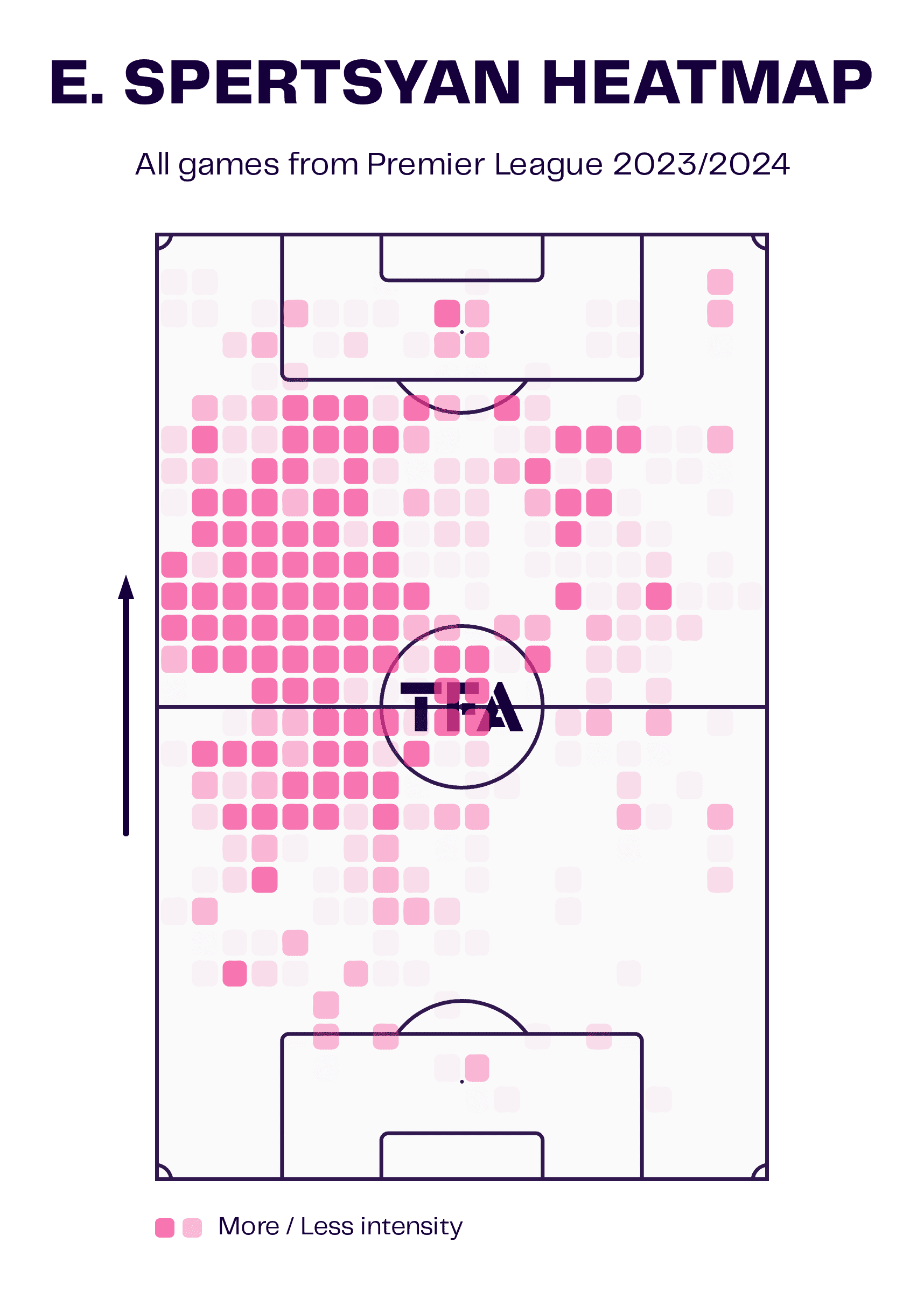
The variety he provides with his passing is extremely important for a Krasnodar team that usually operates with around 55% possession. The Black-Greens are usually efficient with their forays forward and have completed (per game) 70.3% of their 50.83 passes into the final third, 71.6% of their 80.78 progressive passes and 59.5% of their 56.28 long passes.
More simplistically, what Spertsyan offers from midfield is an eye for goal in a team that, while efficient, doesn’t create a high volume of chances. Krasnodar get an acceptable 36.8% of their 11.33 shots per game on target, while they are a threat from set-pieces with 26% of their corners ending in shots. However, the high volume hasn’t necessarily translated to great shot creation as their expected goals (xG) per game is a mere 1.8.
Goalscoring: Impressive, but there’s work to do
In the context provided above, Spertsyan’s role in this team is amplified. At the moment, he is their joint top-scorer in the league alongside 30-year-old Colombian forward Jhon Córdoba, who also has eight goals, with the duo contributing 57.3% of Krasnodar’s league goals this term.
Neither of them is a high-volume shooter and averages just over two shots per game, with Spertsyan’s 2.17 marginally trailing Córdoba’s 2.52, and both get only a little over 35% of their shots on target. However, their xG figures suggest that they essentially take their shots from areas that give them a good chance of scoring.
Spertsyan’s overall non-penalty xG this season is 3.24, and he has scored thrice from open play, indicating that he isn’t over-performing expectations and is simply converting the chances he should be putting away. However, he does make a few questionable decisions with his shooting, as indicated by some of the spots out wide on his shot map below.
When he’s in the box, though, Spertsyan is typically efficient, scoring with two of his nine shots and forcing saves or blocks on six others. Only one of his 26 shots from outside the area has resulted in a goal, with only four others on target, while the majority have been blocked.
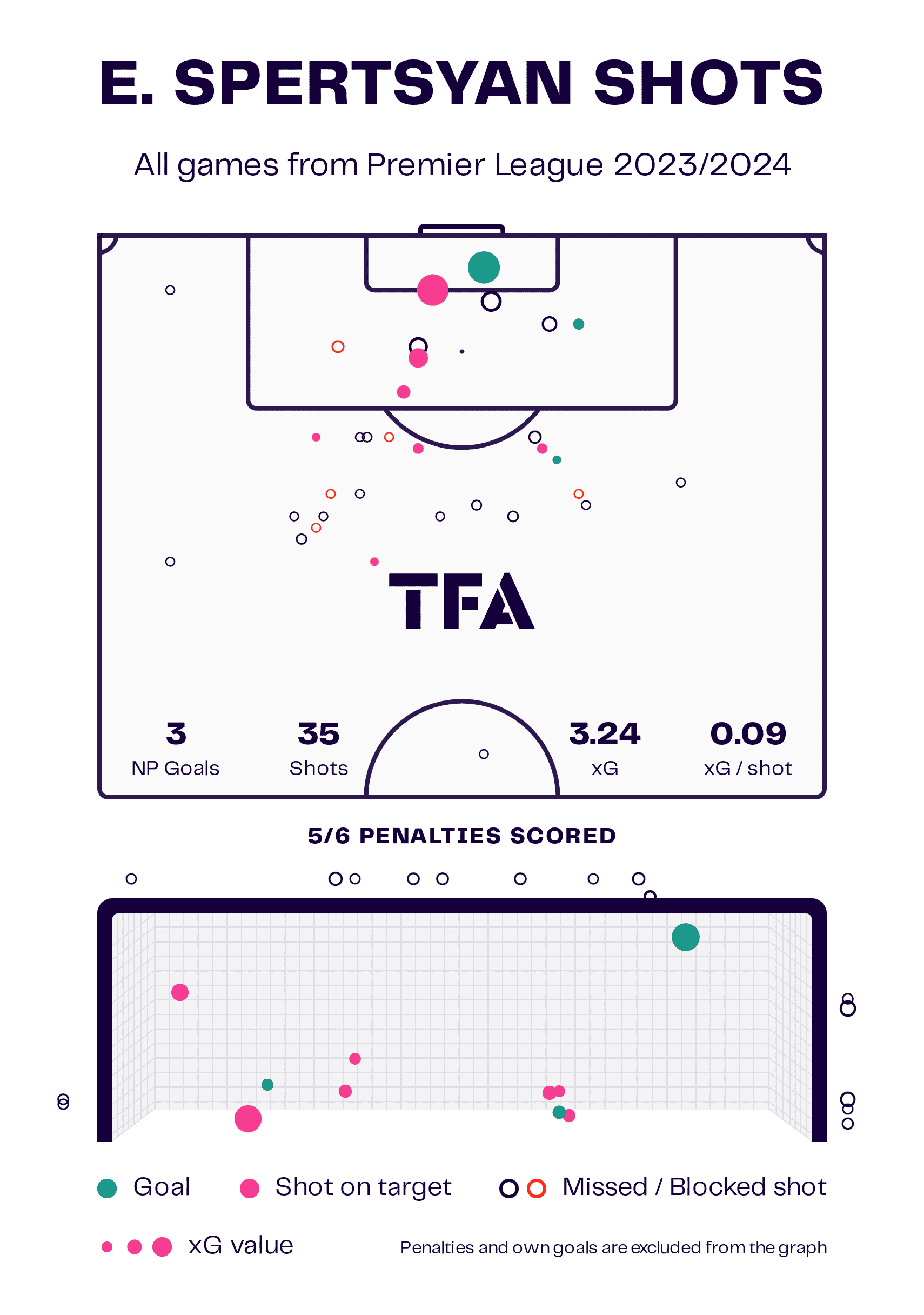
This points to one of the flaws in his game: Spertsyan can be a little trigger-happy with his shots, particularly against low-block defences that block them with ease on most occasions. This was also partly the case last season when 40 of his 67 shots in the league were from outside the area, with only nine on target and two resulting in goals.
However, his outside shooting also occasionally helps Krasnodar surprise teams as opposing defences often focus on Córdoba within the area, with 38 of his 43 shots in the league this season coming from various positions inside the box.
Consider this sequence leading up to the only goal from outside the area Spertsyan has scored this season in a 3-2 win over Rostov in October.
Right from the start, we see a defender each in front of and behind Córdoba (marked in white), with a third hovering in the space close to the edge of the area (all marked in pink). The third man is left in an awkward position, not wanting to leave Córdoba but also concerned about Spertsyan (marked in black) and other Krasnodar players near the edge of the area. He is slow to react, giving Spertsyan time to bend an effort into the bottom corner.
To the Armenian’s credit, though, he changes pace and direction admirably to get to a ball laid off by his teammate, while his finish is measured with pinpoint accuracy. Notice that Córdoba, being an intelligent operator himself, finds space in the midst of a panicky defence. He is open to receiving a pass in an even more dangerous area when the shot comes in.
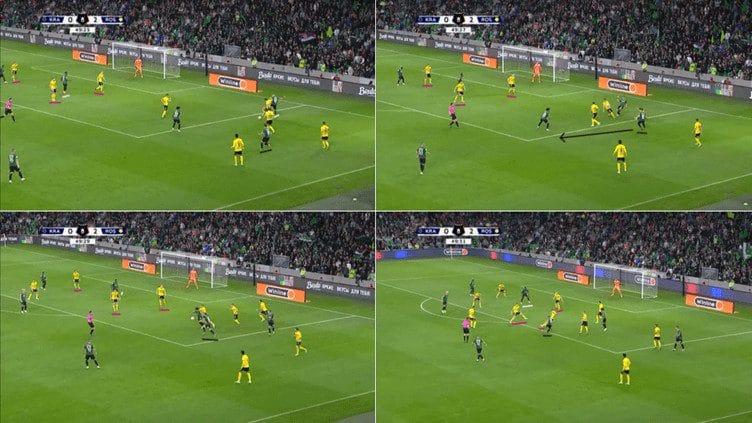
Another of Spertsyan’s open-play goals this term came due to clever movement. In this sequence from Krasnodar’s 2-0 win over Orenburg in August, he is initially in the left-sided space outside the box with two defenders in his vicinity. Still, he follows the move developing on the right. With the defenders caught ball-watching, he moves into space before timing his run into the box. Spertsyan receives a perfectly weighted pass and lets the ball run across him before firing a first-time finish across the goalkeeper to open the scoring in the 67th minute.
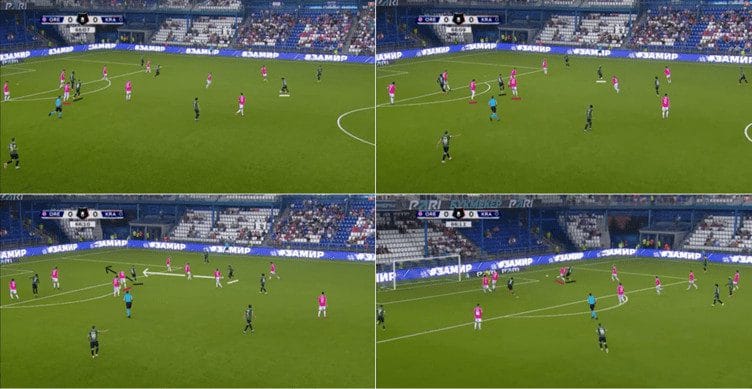
Given his ability to contribute in this fashion, simply giving up an above-average or good shot for a better one could improve Spertsyan’s goal and assist numbers.
On that note, let’s look at the aspect of his goalscoring he has performed well in.
Penalties: Spertsyan’s variety keeps opponents guessing
Last season, Spertsyan took only three penalties in the league and converted them all. This time, he has become their primary penalty-taker and converted five of his six spot-kicks. One factor that has helped him in this regard is variety.
Consider the goal below from Krasnodar’s 2-2 draw with Baltika. Spertsyan initially takes two steps to the side before sprinting forward. He then takes a pause, watching the goalkeeper throughout, before planting his left foot next to the ball with his next step and firing it into the bottom right corner just as the keeper dives the other way.
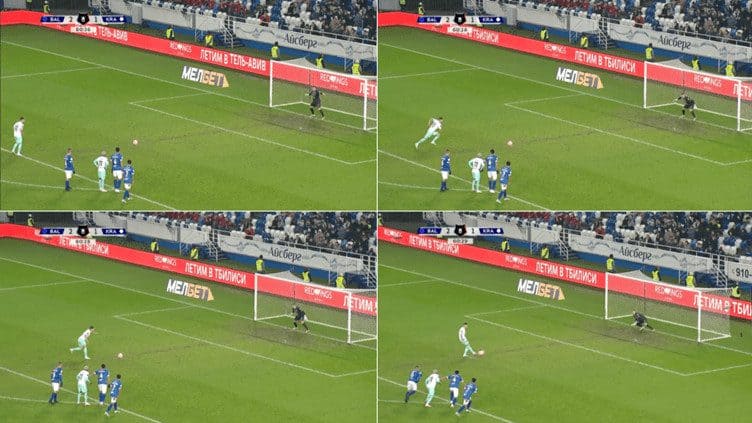
On the other hand, in this penalty against Orenburg, Spertsyan, after his trademark shuffle to the left, sprints straight to the spot and goes for power rather than placement. Despite the goalkeeper diving the right way, the ball finds the bottom corner due to the sheer pace at which it is hit.
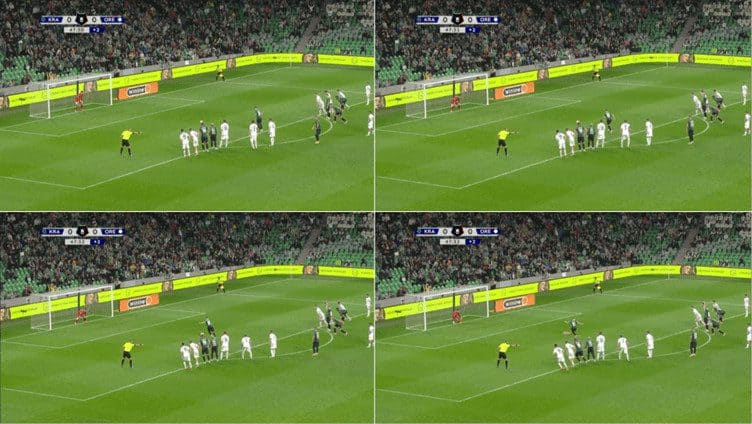
Passing and Creativity: Spertsyan’s numbers have been impacted by Krasnodar’s change in system
With his goalscoring to one side, let’s take a look at Spertsyan’s creative potential. The 24-year-old is a largely astute passer, completing 85.9% of his 38.69 attempted passes per game, including a commendable 61.9% on long balls (2.23 per game). He completes marginally more forward passes (10.23) than backward passes (9.22) per game.
His volume of passes into the final third (4.45) and penalty box (2.81) per game could improve, though, as they have marginally dropped from last season (4.68 and 3.21, respectively). This has, in turn, seen his expected assists (xA) per game drop from 0.22 to 0.08.
Spertsyan’s ball-carrying was one of his significant strengths last season as he attempted 3.81 per game, with a 56% success rate, and 2.93 progressive runs. In the ongoing campaign, he has attempted only 2.39 dribbles per game at a lower but still decent 46.7% success rate, while his progressive runs tally has dropped to 1.96 per game.
This is partly due to Krasnodar’s identity change after a full pre-season under Ivić, who oversaw a more potent offensive team that scored 31 goals and conceded 17 in his 13 league matches in charge last season. This time around, they’ve scored 28 in 18 matches, three fewer in five more matches, but have shored up defensively, letting in only 14.
A quick look at Krasnodar’s heat maps from this season and the last makes the differences somewhat clear. Both teams have more touches in the defensive half, but the difference in the defensive box and offensive half touches stands out, with the latter indicating that Ivic’s team seems to have lost some of its variety in attack.
Krasnodar’s average possession percentage has marginally dropped from 57.17% last season to a little over 55%, and they also attempt 18 fewer passes per game. Their defensive and aerial duels per game have gone up, indicating increased activity on that side of the ball, though they are allowing fewer shots from the opponent (13.13 last season to 10.44 this season).

This is a contributor to Spertsyan’s drop in productivity from 12 assists last season to just one so far this term. As evident from the right chart above, there is limited activity around and ahead of his preferred operating zone in the left half-space. His through-balls per game have dropped from 1.5 to 1.06, with his success rate in that regard also falling from 46.5% to 35%.
However, there have been moments where he has shown he can still cause damage with both his change of pace and passing. Consider the sequence below from Krasnodar’s 1-1 draw with Lokomotiv back in August. After receiving the ball from the left, he turns to spot two open passes and some space ahead of him. Spertsyan chooses to attack the latter and charges forward before threading the needle to find a runner on the right side of the box.
The pass is marginally overhit, allowing the keeper to come out and narrow down the angle, but the vision is immaculate, and the execution almost comes through as well.
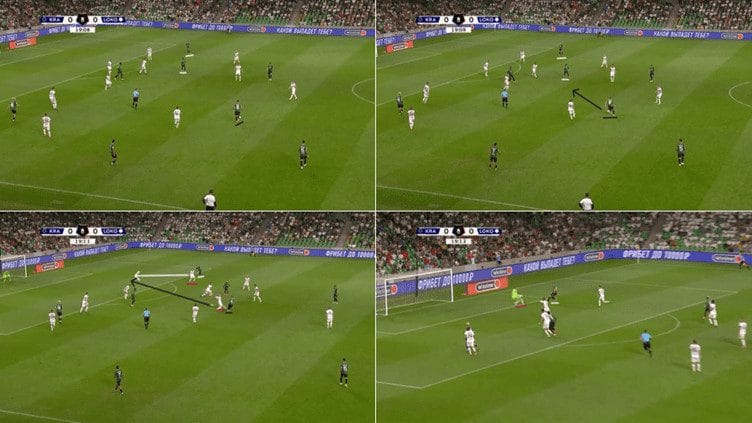
Spertsyan can also play such passes with limited space and time, like in this play from Krasnodar’s match against Baltika. After receiving a pass on the left, he quickly spots the run and plays it into the area. The opposing defender makes a splendid sliding clearance to deny the forward from reaching the ball. However, despite initially being behind two defenders, Spertsyan reacts fastest to the clearance and gets to the ball first, winning a penalty that he then converted to make it 2-2.
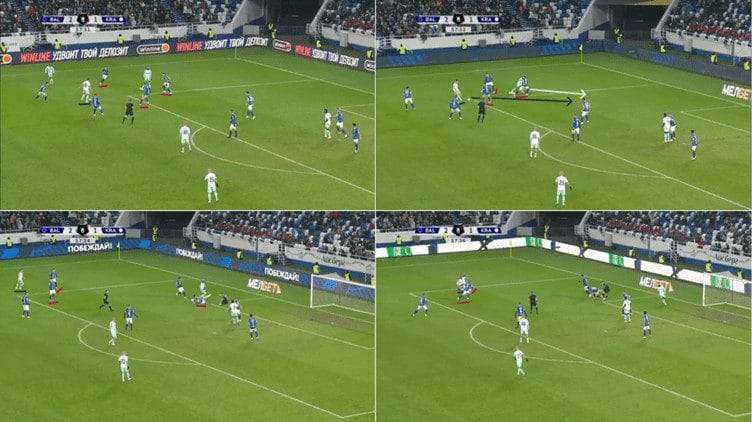
A more successful rendition of these two attempts can be seen in Krasnodar’s win over Orenburg. On the counter, Spertsyan picks the ball up on the right and quickly shuffles away from an indecisive defender concerned with the overlapping run. Having given himself some room to work with, he picks out the runner with a perfectly weighted through-ball, allowing the latter to cut it back for the first time. Orenburg cleared their lines as no teammate was in the box, but this is the kind of position Spertsyan needs to get into more to influence games with his passing.
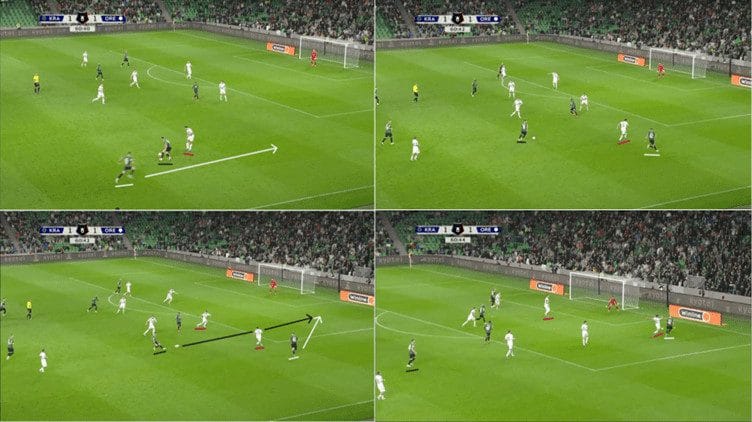
Weaknesses: Defensive Lapses
Spertsyan has been linked to some of the top clubs in Europe due to his attacking attributes, including his passing range, eye for goal and intelligent movement. However, to excel in the midfield of those clubs, he will need to work on his defensive game.
The Armenian has had several defensive lapses throughout the season, particularly in transitions and counter-attacks. Some of his surface numbers are good – he has averaged 2.76 interceptions and 5.62 recoveries (54.7% in the opposing half) and usually wins his slide tackles (83% success rate on 0.32 per game). However, he has struggled to win loose ball duels (28.9% success rate), and, at 5’10”, he struggles with aerial duels as well (33.3% success on 1.91 per game).
Consider the following opposing counter-attack from Krasnodar’s latest match, a 1-0 win over CSKA Moscow. With the ball played to the flank, two Krasnodar players rush to close down the attacker. Rather than closing down the only passing outlet, Spertsyan tries to become a third presser, instead opening space for the player out wide to find his teammate in-field, who has acres of space to run at a retreating defence. Luckily for Krasnodar, the latter’s touch is poor, and they regain possession inside their own half.

His tracking back can also be a little negligent at times, as evident in the following sequence from their match against Ural. Spertsyan initially trails the play, which is understandable given the opponents counter following a Krasnodar attack. He initially jogs alongside an opponent who shows no genuine desire to push forward before realising that his teammates are outnumbered further up the pitch. By the time he makes that read, it’s fairly late, and the ball is played out wide, with the opposition attacker having plenty of space to venture into.
Spertsyan is evidently tired as this is late in the game, but at 1-1, he needs to put in more effort to cover up spaces, as it could potentially lead to his team losing in stoppage time.
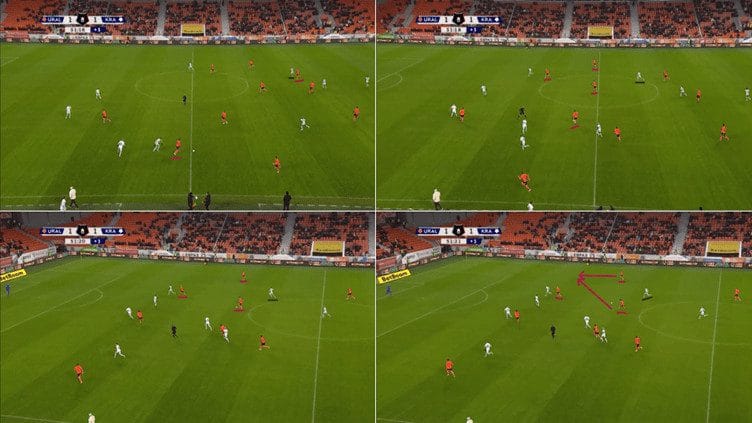
Apart from his defensive focus, another area Spertsyan needs to improve is his ball retention. The Armenian has averaged 10.92 possession losses per game in the league, with roughly 1/3rd of them in his own half. He does make up for this to a degree by winning 1.38 fouls per game, but that number is quite low, and as the map below shows, only a handful are close to the penalty area and provide genuine goal-creating potential.
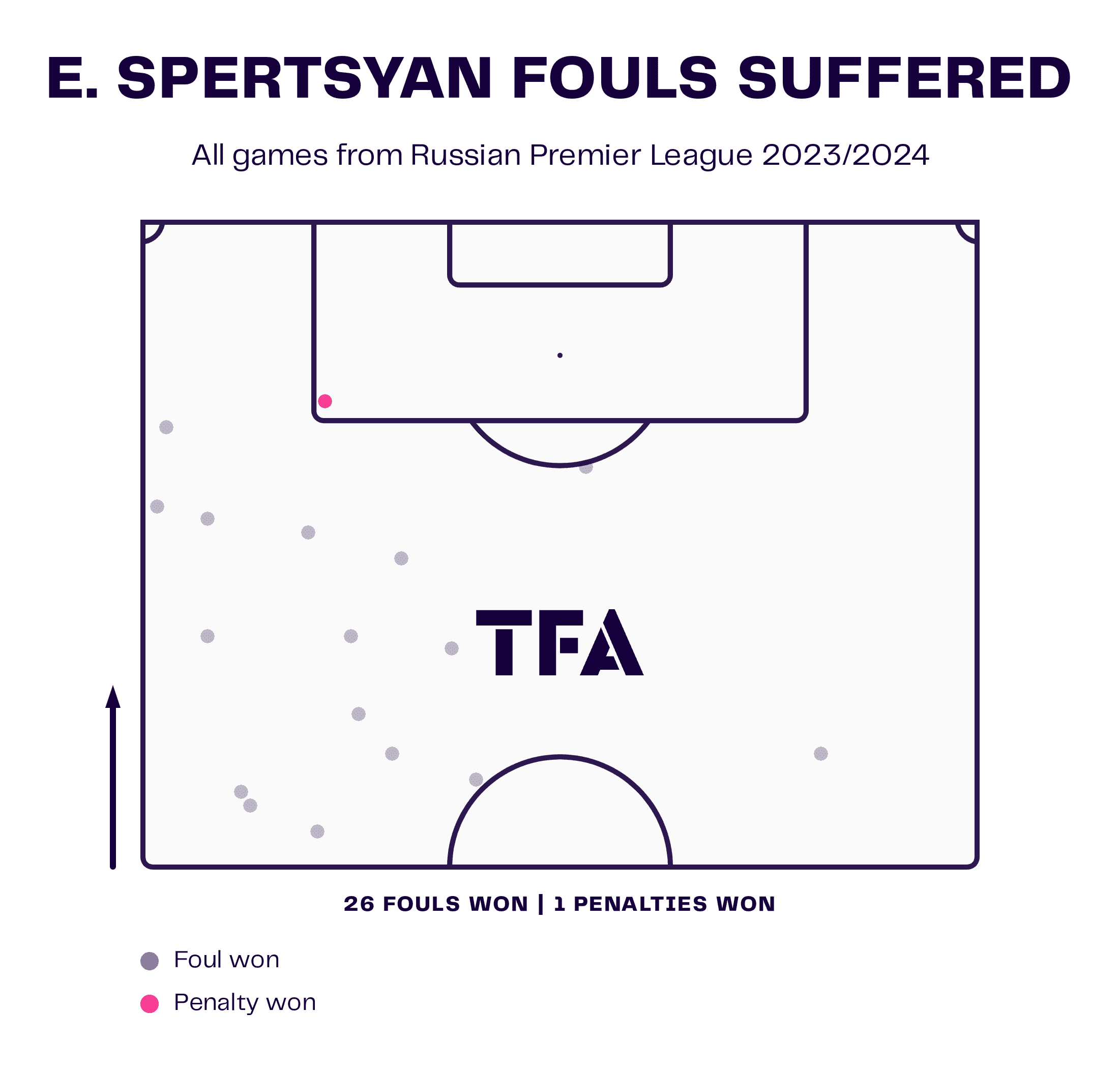
Conclusion
Eduard Spertsyan possesses many qualities that could make him a world-beater in the near future. He has a good shot on him, can finish well with either foot, and his passing ability is excellent and on the rise. In his current guise, the 23-year-old could easily do a job for an injury-ravaged Newcastle United or an Ajax team in need of an uplift, with both teams desperately needing goals from midfield.
However, his decision-making and defensive awareness require improvement if he is to thrive in any of Europe’s top leagues. At the same time, he also has to protect the ball better and be more brave with his forward carries and passes. The drop in his numbers from last season to this one could be attributed to Krasnodar’s change in system and tactics. Still, as explored above, some of his underlying stats have taken a deeper drop than others, bringing into question a personal drop-off as well.
He has already accomplished plenty at 23. With more work on the training ground and a return to the potential he showed last season, Spertsyan could very well be playing for some of the best clubs in Europe.





Comments